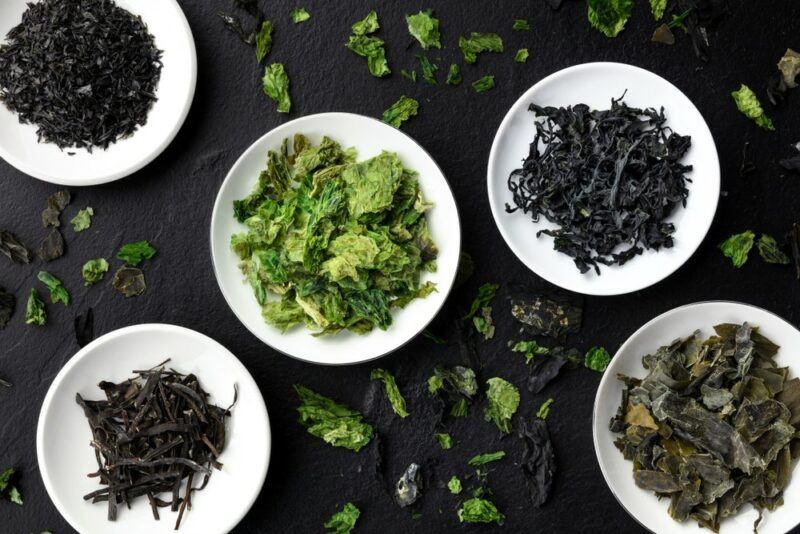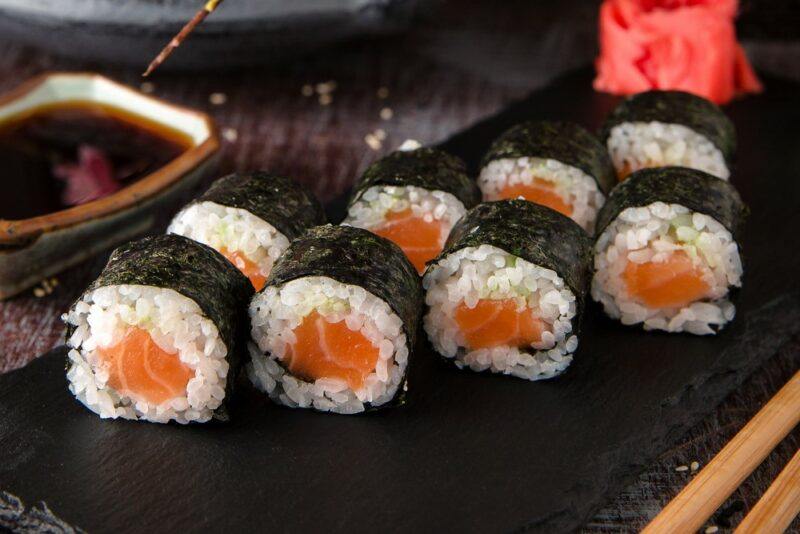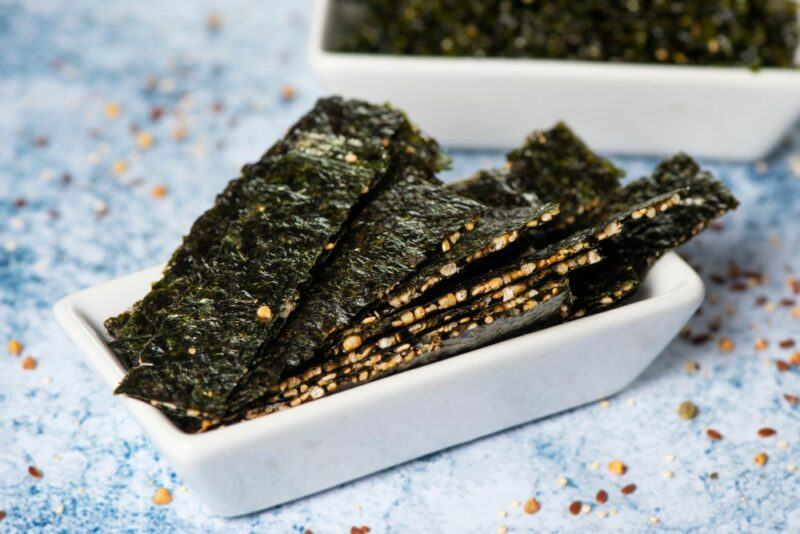
Seaweed is one of those ingredients that doesn’t sound that appealing when you first hear about it. Who wants to eat slimy seaweed, right? Yet, the more you read about seaweed, the better it may sound. Seaweed is even seen as a superfood these days, one that offers provides plenty of nutrients and a host of other benefits. Seaweed is getting more common these days too, featuring as an ingredient in your smoothies, wrapped around sushi, or served as dried seaweed snacks instead of chips.
What about the health effects though? Is seaweed good for you? And, if it is, how much seaweed should you be eating? After all, too much of anything can be harmful (and, actually, it’s very easy to overdo it with seaweed).
If you’re going to eat seaweed regularly, then finding high-quality products is important. Doing so keeps the risk of contamination as low as possible. Buying seaweed online can work particularly well, as most companies provide details about where they source their seaweed from and how they keep you safe.
Is Seaweed Good For You?
- Types Of Seaweed
- What Does Seaweed Taste Like?
- Benefits Of Seaweed
- How Seaweed Could Be Harmful
- How Does Seaweed Affect Your Thyroid?
- How Do You Use Seaweed?
- Can Vegans Eat Seaweed?
- Final Thoughts
Types Of Seaweed

Let’s start by talking about seaweed itself. The term is used for marine algae, which look a little like marine plants. Despite the appearance, seaweed isn’t a type of plant at all.
For one thing, plants have an internal vascular system. This isn’t true for algae at all. Plants also have roots, seeds, and flowers as well, none of which you’ll find with algae.
This means that seaweed really is in a class of its own. It offers some of the same benefits that you get with plants, along with plenty of different ones.
Before we get into those benefits though, we need to talk about some of the different types. Not all of them though, as there are more than 10,000 individual species of seaweed.
In general, seaweed falls into three categories: red algae, brown algae, and green algae. Then there are the popular varieties that you’ll find in Japanese cooking and many other places.
- Nori. This type of seaweed is typically dried and pressed into thin layers. You’ll often see it used to wrap sushi and pieces of nori work well as a garnish too. The thinness of the product makes nori an excellent choice for creating seaweed chips and a versatile ingredient.
- Kombu (or kombu kelp). There are plenty of species here, each with its own distinct flavor. Regardless of the species, kombu tends to be thicker than nori with a texture that’s a little like leather. It’s also exceptionally high in iodine.
- Wakame. This is the type of seaweed that you find in miso soup. It’s dark green and has a slightly sweet flavor.
- Hijiki. This type of seaweed is less common and looks a little like dried tea leaves. It also needs to be rehydrated before you can work with it, but this isn’t too difficult.
- Iwanori. The name iwanori translates to rock seaweed because of where the seaweed is found. It’s similar to nori, but with a more aromatic flavor. Iwanori is typically dried before being eaten and can be easily sprinkled on top of meals.
Is Spirulina Seaweed?
Spirulina and chlorella are often lumped together with seaweed, offering many of the same benefits. The most obvious difference is that seaweed tends to look like leaves from a plant, while spirulina and chlorella are sold as powder and tablets instead.
Spirulina, chlorella, and seaweed are similar – as they’re all types of algae, but they’re not the same. Think of the distinction as being similar to how chicken, duck, and beef are all types of meat – just very different types.
That being said, most of the benefits and risks of seaweed do apply to spirulina and chlorella too.
What Does Seaweed Taste Like?

Seaweed is best described as tasting like the ocean. This doesn’t mean that it’s fishy, not exactly. Instead, seaweed has a strong salty and mineral flavor.
The salty flavor isn’t overbearing either. It’s something that you notice for a minute and then is gone.
However, the flavor does vary depending on the type of seaweed that you use. You might need to experiment to find the type of seaweed that you like the most.
Some companies also focus on creating seaweed products with more complex and nuanced flavors. Such products are worth trying if you’re looking for an interesting ingredient.
Benefits Of Seaweed
An Excellent Source Of Nutrients
Seaweed is famous for being incredibly nutrient dense. It contains a decent amount of vitamin B12, magnesium, calcium, iodine, and iron, along with lower amounts of other nutrients.
That’s not all. Seaweed is also very low in calories and fat. This makes it a very easy way to boost your nutrient intake.
The nutrient balance depends on the type of seaweed you choose. Dried purple and green seaweed both contain vitamin B12, while other types may not.
Provides Plenty Of Fiber And Protein
Seaweed might not be a type of plant, but it still provides a decent amount of fiber. This fiber is important, as fiber is what keeps our digestive systems running well.
That’s not all. Some of the fiber in seaweed has a prebiotic function, meaning that it acts as food for the bacteria in our gut.
Seaweed provides a surprising amount of protein too. For example, two tablespoons of wakame seaweed gives you around 0.3 grams of protein.
That might not sound like a lot, but we are only talking about two tablespoons of seaweed. You can easily add that to shakes or a little water to boost your protein intake.
Getting plenty of fiber and protein in a low calorie ingredient is always good news for weight loss. Both macronutrients help to decrease your hunger, so they could reduce the amount that you eat in your next meal or mean that you snack less.
Of course, there’s plenty of variation from one type of seaweed to the next.
Can Help With Diabetes
Seaweed could be a relevant snack for anyone with diabetes too. The first reason is the fiber content, as fiber helps to regulate blood sugar levels. Having fiber rich foods regularly helps to decrease blood sugar spikes, which is an important effect.
Seaweed may help in other ways too, helping to decrease some of the risk factors for diabetes. It’s even possible that some compounds in seaweed help with diabetes directly (although more research is needed).
Often Contains Antioxidants

Antioxidants have become famous these days. They’re powerful plant-based compounds that can reduce free radical damage and lower the risk of some diseases.
Seaweed may be surprisingly powerful here, giving you plenty of antioxidants, including flavonoids and carotenoids, along with some of the antioxidant vitamins, like vitamin A and vitamin E.
These antioxidants could also help to lower inflammation throughout your body and even boost your immune system.
Contains DHA And EPA Omega 3 Fatty Acids
Fish is the most famous source of omega 3 fatty acids, but you can get these same fatty acids from seaweed as well.
Even more importantly, seaweed contains DHA and EPA. These are the most bioactive forms of omega 3 fatty acids, the ones responsible for the most health benefits.
While DHA and EPA are both common in fish and shellfish, it’s unusual to find them in any vegetarian-friendly food. This effect makes seaweed particularly powerful.
In contrast, most plants contain ALA. This form of omega 3 still has some benefits, but it needs to be converted into DHA and EPA to be most useful and that conversion happens at a low rate.
The benefits of omega 3 fatty acids are well-known. They’re often associated with improved heart health, better mental health, decreased inflammation, and many other benefits.
Wakame seaweed is one of the best choices for omega 3, giving you plenty of that fatty acid, while the omega 6 content is low.
How Seaweed Could Be Harmful
Too Much Iodine
Seaweed can be exceptionally high in iodine. While iodine offers plenty of benefits, too much iodine can easily put your health at risk.
Kombu kelp is the biggest problem here, as even a small serving contains many times your daily iodine intake. Nori is a much safer choice, but it still contains a decent amount.
If you’re just having a little seaweed every so often, then the iodine content isn’t much to worry about. The problem is that seaweed is often promoted as a superfood – creating the impression that the more you have the better.
You can even find seaweed chips. Those are low in calories and seem like a much healthier option than regular potato chips. Seaweed chips are healthy, true, but rely on them too much and you could easily make yourself sick.
Don’t forget that you’re getting some iodine from other sources too, including iodized salt and other fortified foods, so you probably aren’t deficient in the mineral.
Heavy Metal Contamination

All marine life can be contaminated with heavy metals, including mercury, lead, and cadmium. This problem is only getting bigger with the growth of modern industry and all the problems going on with our marine environment.
To make matters worse, seaweed tends to absorb toxins, an effect that could make them unsafe to eat.
Thankfully, levels of contaminants in seaweed are often low– generally well below the maximum safe thresholds. However, you still need to be careful, as the level of testing and quality control isn’t always as good as it could be.
To get around the issue, try looking for high-quality companies, ones that source seaweed from uncontaminated waters and take every possible step to protect their customers.
Can Interfere With Medication
Seaweed is a decent source of vitamin K, so it can interfere with some blood thinning medications.
This problem is easily mitigated by talking to your doctor. You can then have your medication levels adjusted to account for your seaweed intake.
How Does Seaweed Affect Your Thyroid?
Seaweed is often promoted as a way to improve your thyroid health. The importance is easy to see, as the hormones produced in your thyroid have many important effects, including regulating your energy levels, mood, blood pressure, and heart rate.
Sometimes the thyroid doesn’t function as it should. In hypothyroidism, the thyroid isn’t producing all the hormones that you need. Thyroid medication is the most effective way to make things better, but making wise food choices might help as well.
Seaweed is important because it contains tyrosine and iodine. Both of these compounds help to support thyroid function, getting your body back on track.
The iodine is particularly important, as seaweed is such a rich source of the mineral.
However, the amount of iodine varies depending on the type of seaweed. Kombu is the most significant source, giving you more than 1,500% of your daily iodine intake in a single gram of kombu.
Wakame contains much less, but you’re still getting more than 90% of your daily iodine intake per gram.
That said, seaweed isn’t always the best choice. It’s incredibly rich in iodine – and too much iodine can make thyroid problems worse. This means you need to be cautious with the amount of seaweed you eat, especially if you’re focusing on kombu.
Be particularly careful if you’re also taking iodine supplements, as doing so risks pushing your iodine levels up even further.
Besides, iodine deficiency is rare in the United States. This means that a lack of iodine isn’t often the reason for thyroid problems.
How Do You Use Seaweed?

Seaweed is sometimes eaten purely for its health benefits. However, it’s often chosen for the flavor as well – because seaweed has an umami taste, one that can make your meals taste much more interesting.
Regardless of whether you’re interested in the benefits or the flavor of seaweed, there are plenty of ways to use it, like the following:
- Make or buy dried seaweed chips
- Add some seaweed to toast, perhaps with avocado or smoked salmon as well
- Mix small pieces of seaweed into hummus
- Toss dried seaweed flakes in with your popcorn
- Use it to make sushi
- Include seaweed as a soup ingredient
- Sprinkle small pieces of dried seaweed on top of pretty much any meal
- Look for seaweed-containing products, like seaweed crackers (just make sure they use real seaweed as an ingredient)
Can Vegans Eat Seaweed?
While seaweed isn’t quite a plant, it certainly isn’t an animal either. As such, it’s an easy addition to a vegan diet.
In fact, algae products (including seaweed and spirulina) can be very important for vegans, giving you some nutrients that you might struggle to get otherwise, including omega 3 fatty acids and vitamin B12.
Final Thoughts
It’s not a stretch to say that seaweed is a nutrient-dense superfood food, as long as you remember that a little goes a long way. The high iodine content and risk of heavy metal contamination means that having too much seaweed could easily make you sick.
Remember too that many foods are rich in nutrients. Eating a wide variety of healthy foods is often the best choice, as this helps you avoid overconsumption of any particular compounds.
Frequently Asked Questions
Can You Eat Seaweed While Pregnant?
You can consume some types of seaweed while pregnant, but you need to pay attention to the type and your serving size.
Part of the problem is the iodine content, as too much iodine can cause a variety of issues. Green and red seaweed is your best choice, as this is lower in iodine than brown seaweed.
You should also pay attention to the sodium content, as this can be high in some seaweed products. Lower sodium dried seaweed and fresh seaweed tend to be the best choices. Otherwise your sodium intake may end up being too high.
Is Seaweed Keto?
Yes. Seaweed is naturally low in carbs, so it is an easy fit on a keto diet. For example, a cup of fresh seaweed gives you around 7 net grams of carbs.
However, the carb content varies depending on the type of seaweed, where it was grown, and how it was prepared. You’ll need to pay attention to your portion sizes too, especially for dried seaweed.
Is Seaweed A Vegetable?
Seaweed is sometimes called the vegetable of the sea. It does have many of the properties of traditional vegetables too, including being a decent source of fiber and nutrients, and being low in calories.
However, there are differences too, including the way that seaweed absorbs iodine from its environment. Seaweed is also grown and eaten differently than traditional vegetables, so it really belongs in a category all of its own.
How Much Seaweed Is Too Much?
It’s crucial to be cautious with seaweed. While it’s very nutritious, the iodine content and sodium can be dangerous in high doses. There’s the risk of heavy metal contamination too.
Because of this, it’s best to limit your intake. Having perhaps around 5 or 10 grams of dried seaweed per day could be enough to give you the benefits of seaweed without putting your health at risk. You might need to drop your intake lower for brown seaweed, as this is much higher in iodine.
Talking to your doctor helps too – as the optimal amount of seaweed differs dramatically from person to person. For example, if you’re pregnant or have a thyroid condition, you might need to be much more cautious than if you’re healthy.
Is Seaweed Gluten Free?
Seaweed is naturally gluten free. The risk of gluten contamination is also low, due to where seaweed grows.
But, you still need to be careful with processed seaweed products and foods that use seaweed as an ingredient, like sushi. While some such foods may be gluten free, others will not be.

















 15 Best Foods For Dental Health, Plus Three Fabulous Food Combinations For Addressing Dental Health Immediately
15 Best Foods For Dental Health, Plus Three Fabulous Food Combinations For Addressing Dental Health Immediately
Leave a Reply